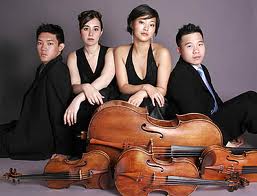|
Choral and Vocal
CANTIAMO SONOMA'S LUSCIOUS A CAPELLA SINGING IN SEASON ENDING CONCERT
by Pamela Hicks Gailey
Sunday, June 8, 2025
Symphony
SRS SEASON ENDS WITH RESOUNDING TA-TA-TA-BANG
by Terry McNeill
Sunday, June 1, 2025
Symphony
YOUTHFUL VIRTUOSITY ON DISPLAY AT USO'S MAY CONCERTS
by Peter Lert
Saturday, May 17, 2025
Symphony
MYSTICAL PLANETS AND LIVELY GERSHWIN ORTIZ AT FINAL SRS CONCERT
by Peter Lert
Sunday, May 4, 2025
Symphony
VSO'S CONCERT MUSIC OF TIME, MUSIC OF PLACE
by Peter Lert
Sunday, April 27, 2025
VOCAL ELEGANCE AND FIRE AT THE 222'S RECITAL APRIL 26
by Pamela Hicks Gailey
Saturday, April 26, 2025
CANTIAMO SONOMA SINGS AN INSPIRED GOOD FRIDAY MOZART REQUIEM CONCERT
by Pamela Hicks Gailey
Friday, April 18, 2025
DRAMATIC SHOSTAKOVICH SYMPHONY CLOSES PHILHARMONIC'S 25TH SEASON
by Terry McNeill
Sunday, April 13, 2025
LARGE COLLEGE OF MARIN AUDIENCE GREETS STOPHER ARTISTRY
by Terry McNeill
Saturday, April 5, 2025
Chamber
FRISSON DELIVERS SHIVERS OF DELIGHT
by Abby Wasserman
Sunday, March 30, 2025
|
 |
 Parker String Quartet |
SOLID GOLD FROM THE PARKER STRING QUARTET
by Steve Osborn
Friday, February 15, 2013
Santa Rosa has been blessed with three superlative chamber music concerts during the past month, beginning with the Calder String Quartet in late January, followed by the Alexander String Quartet with violist Toby Appel in early February, and culminating with the Parker String Quartet one day after Valentine's Day. Choosing among the three ensembles is a difficult task, but I think the gold would ultimately go to the Parker, which proved itself capable of playing even the most difficult music with precision and Úlan.
Sadly, the Glaser Center in downtown Santa Rosa was only about half full for the Grammy-winning Parkers, but that didn't seem to dampen the musicians' or the audience's enthusiasm. All four members of the quartet, each one more youthful than the other, played as if on fire from the opening note to the last. The opening work, appropriately enough, was from the ever-youthful Mozart, one of his six "Milanese" quartets, written when he was a teenager. This one, K. 156, is in G Major.
The inner voices in the quartet--second violinist David McCarroll and violist Jessica Bodner--instantly established themselves as a force to be reckoned with, playing out their lines in equipoise with their outer brethren: first violinist Daniel Chong and cellist Kee-Hyun Kim. (During the current season, Mr. McCarroll is replacing regular second violinist Karen Kim, who is on sabbatical.) As is often the case with Mozart, the slow movement was the most riveting section, and the Parker played it as if it were one of the composer's mature works, bringing out its exquisite lines and delicate counterpoint.
In brief remarks after the Mozart, Mr. McCarroll said he was glad to be home (he grew up in Sonoma County) and that the just-played quartet and the Dvorak quartet to come in the second half were relatively obscure works. The true center of the program, according to him, was the impending Debussy string quartet, a fixture in the repertoire since its premiere in 1893. The performance that followed demonstrated not only why the Debussy has become canonic, but also how much more this masterpiece still has to offer.
To hear the Parker play the Debussy quartet was nothing short of a revelation. In the first movement all the familiar lines and turns of phrase took on new meaning when played with such precision and understanding. The playing was assured from the opening measures, when opulent legatos gave way to sharply articulated retakes (repeated down-bows). Words such as "flawless," "lapidary" and "impeccable" can only begin to describe the seamless blending, the sudden dynamic changes and the emotive playing, particularly from Mr. Chong.
Ms. Bodner took center stage in the second movement, playing all 13 iterations of her 13-note phrase as if each was a distinct event. In contrast to Mr. Chong's emotive swaying, she held herself aloof, letting her fingers dance across her instrument of their own accord. Her tone was absolutely gorgeous. The movement, marked "lively and rhythmic," seemed to float above the earth like a scudding cloud, with sudden thunder from the cello adding a touch of drama.
The slow third movement continued the gorgeous sound, and here again Mr. Chong captivated the audience as he sang out his expressive lines. When the final movement began, one could only sit back and be entranced by the sparkling musicianship from all four corners of the stage. The ending came all too soon.
Dvorak and Debussy both begin with the same letter, but there the similarity more or less ends. Debussy was a musical revolutionary, but Dvorak was content to use the existing forms and imbue them with his own optimistic style. His eleventh string quartet in C Major, Opus 61, closely resembles his dozen or so other quartets, with an Allegro opening movement, an Adagio second, a minuet-style third and a Vivace conclusion. The melodies are bright and open, and the feeling is often happy and buoyant.
There was absolutely nothing wrong with the Dvorak, but it sounded tame in comparison with the Debussy. Dvorak's technique is more limited, his imagination less captivating. Nonetheless, the performance was exhilarating. Mr. Chong drove forward with breathtaking speed; Mr. McCarroll sang out whenever the opportunity presented; Ms. Bodner reveled in the many viola solos (Dvorak was a violist); and cellist Kim provided a rock-solid foundation throughout. They were as much fun to watch as they were to hear.
At the end, the only regret was that more people weren't there to hear this magnificent group, which had been brought to town through the auspices of the Redwood Arts Council. The Glaser Center is an excellent venue for chamber music, and it's centrally located, with plenty of parking. There's even a friendly lobby with food and drink during intermission. What's not to like?
|
